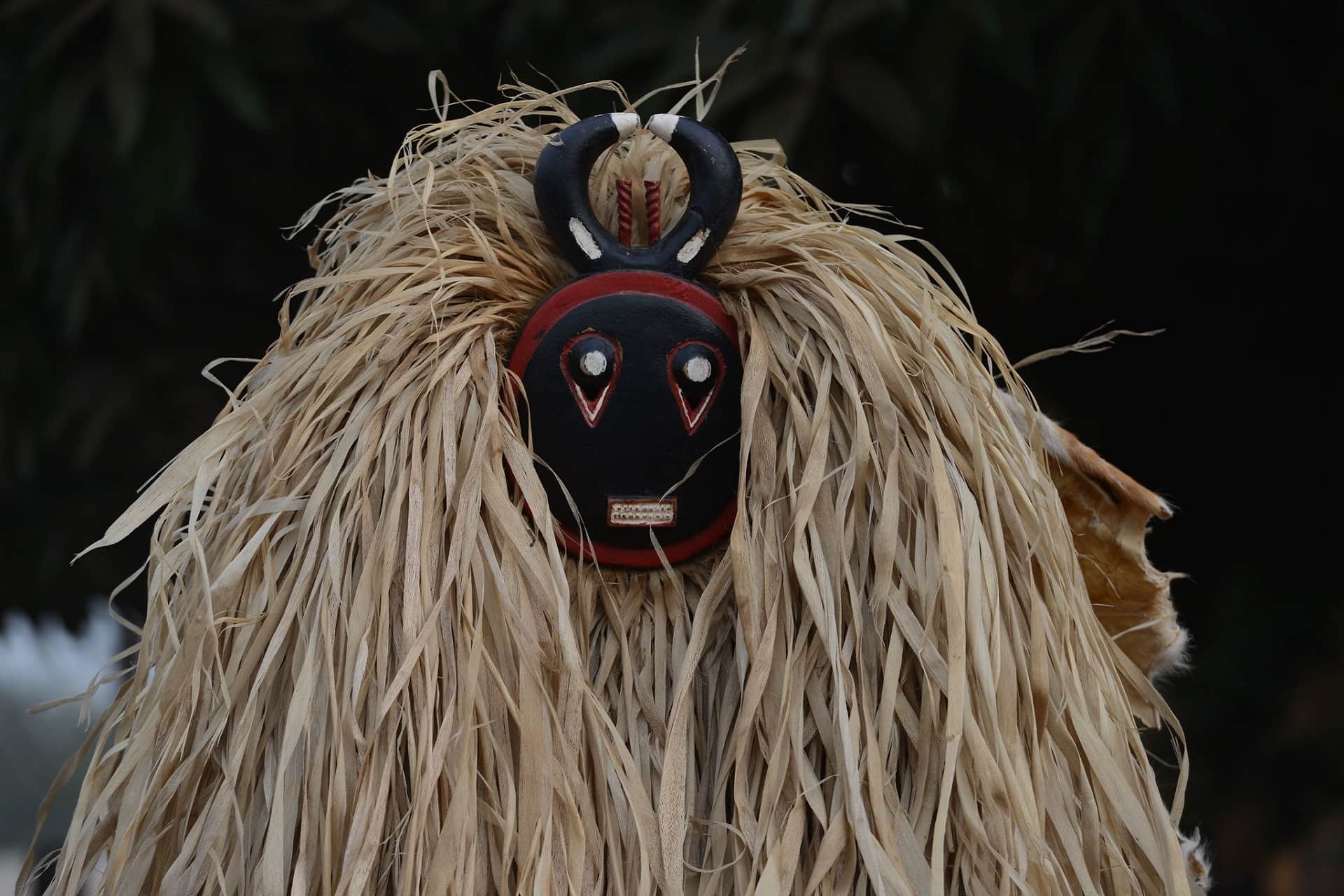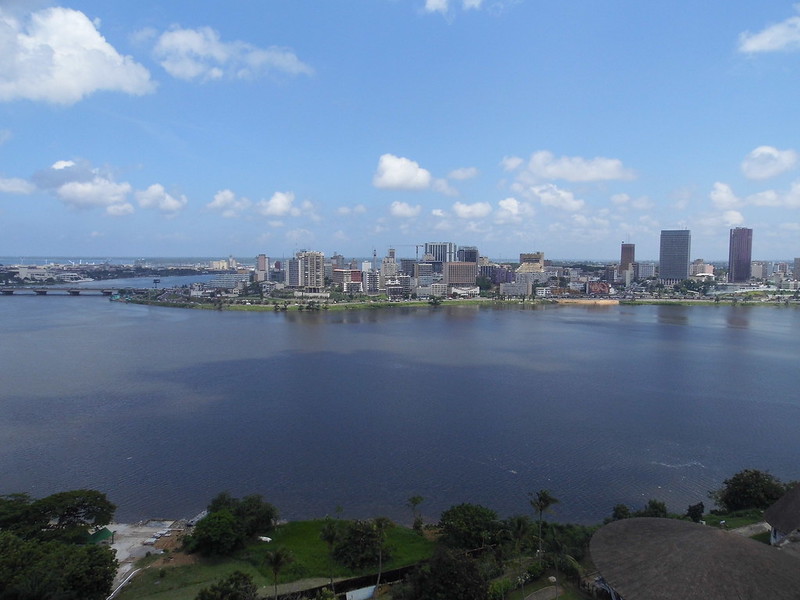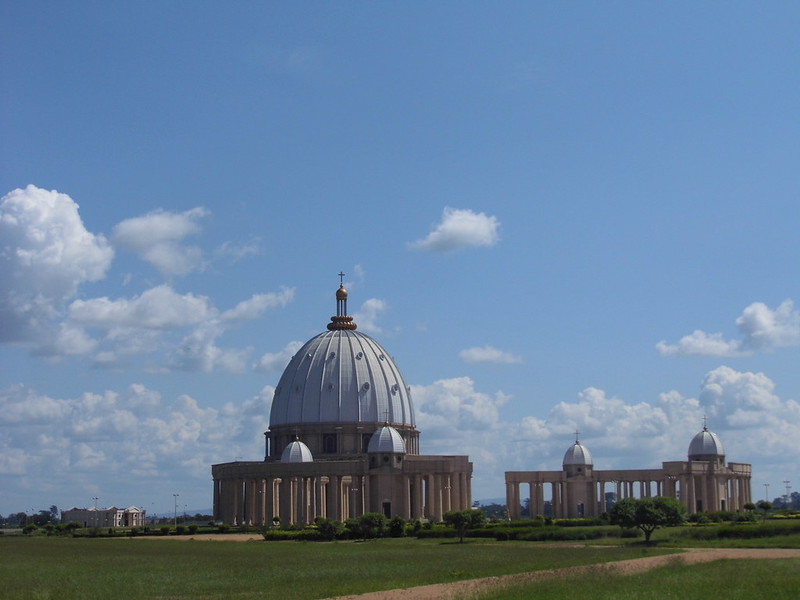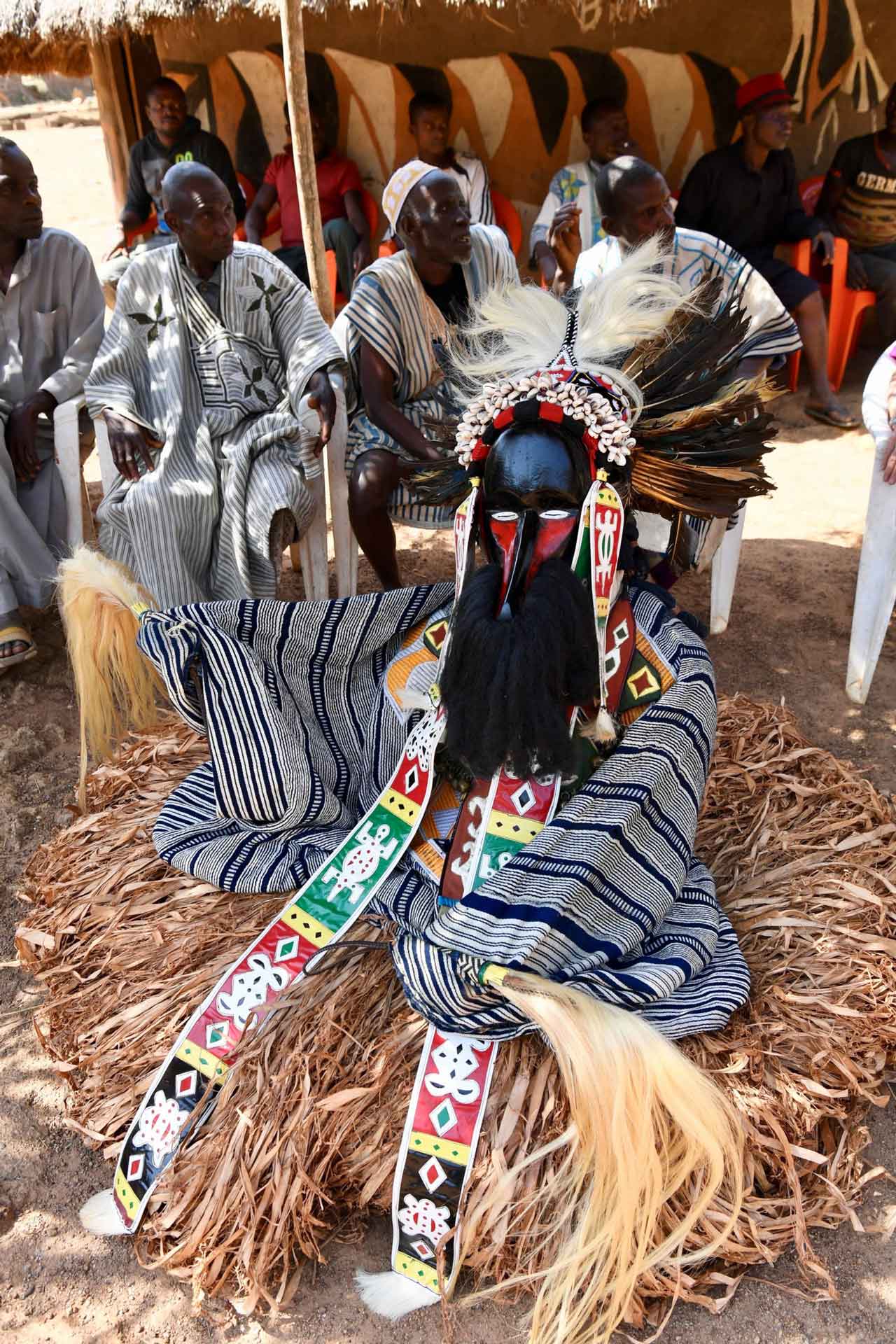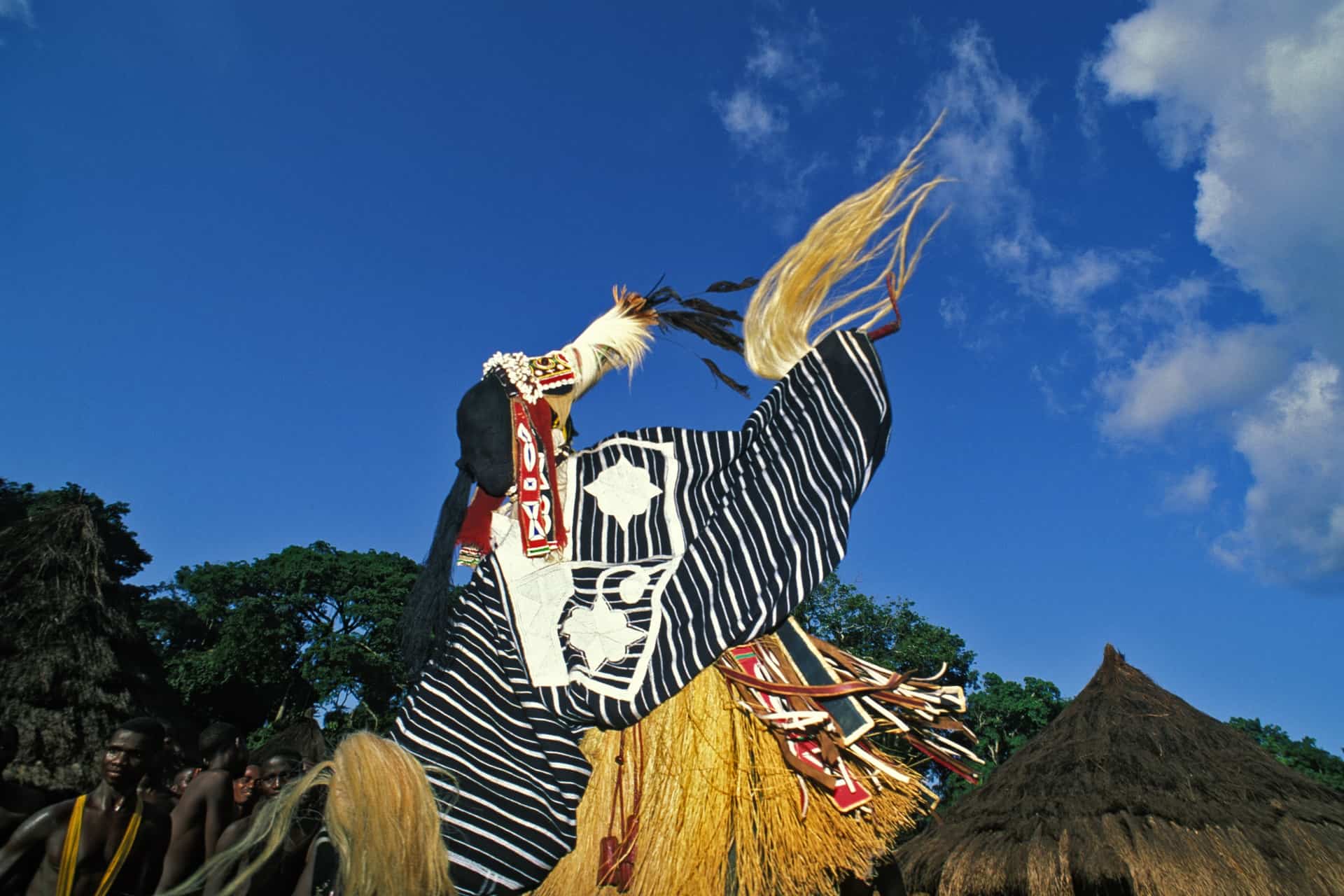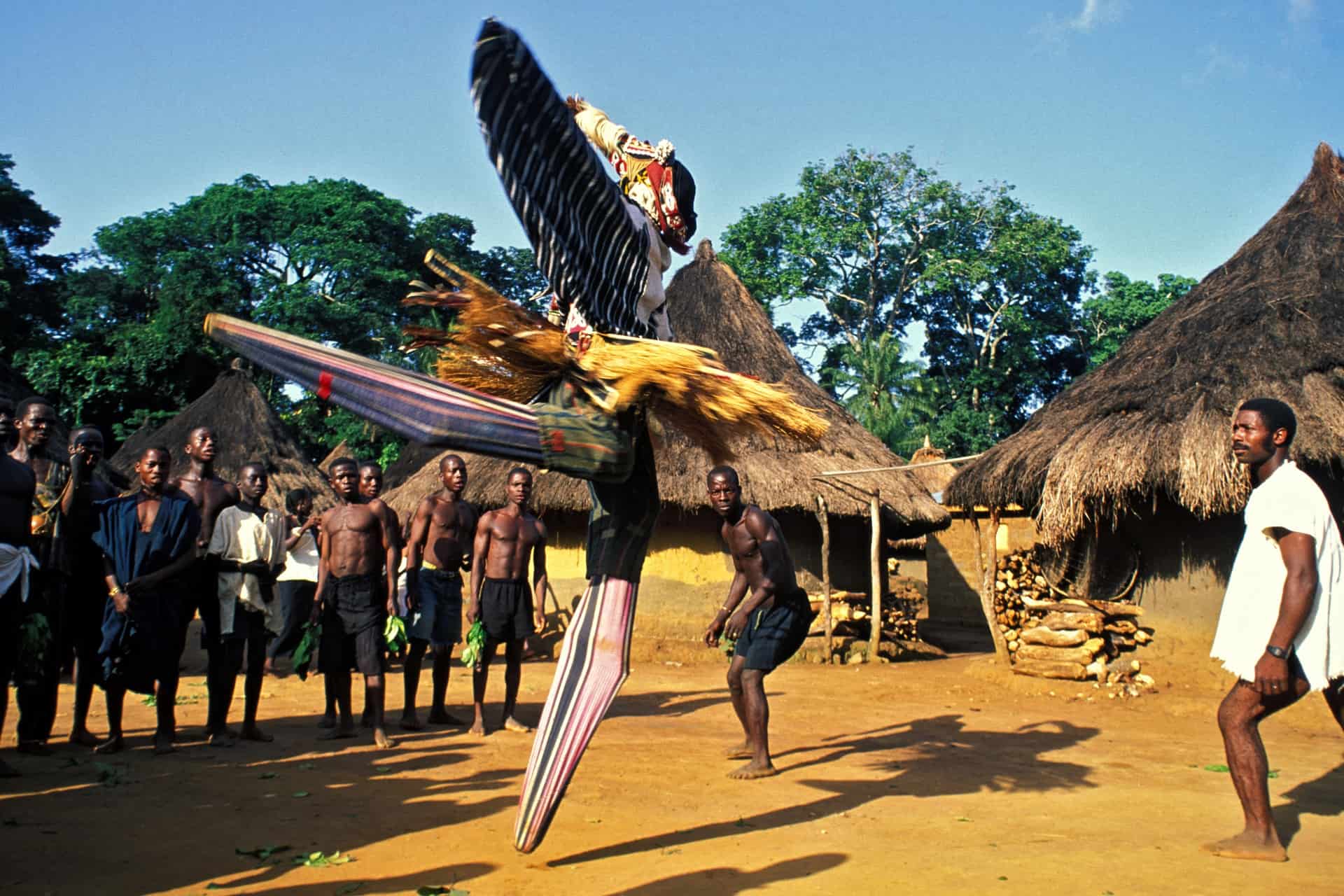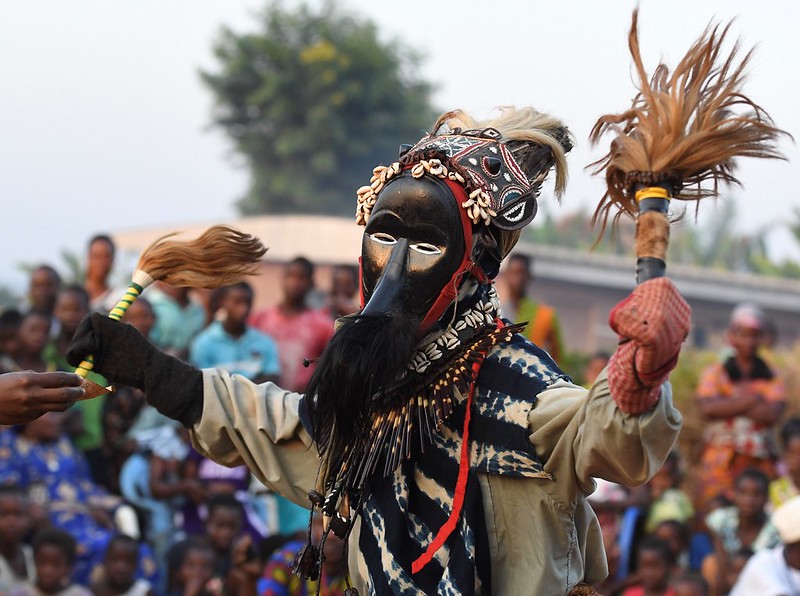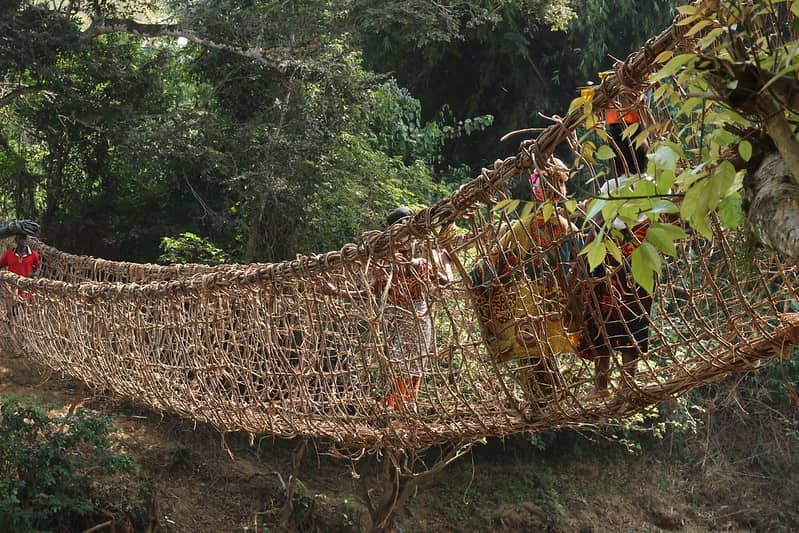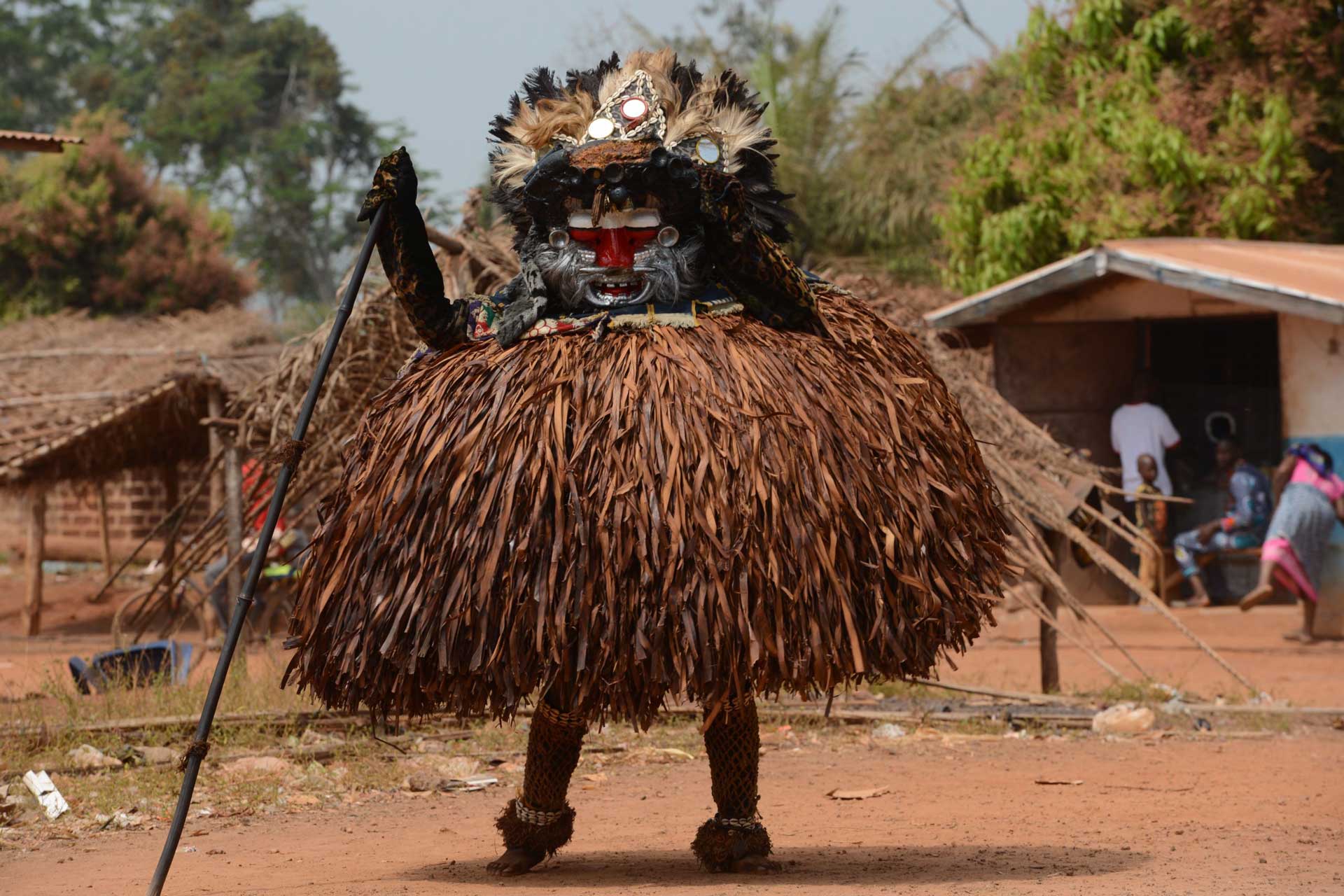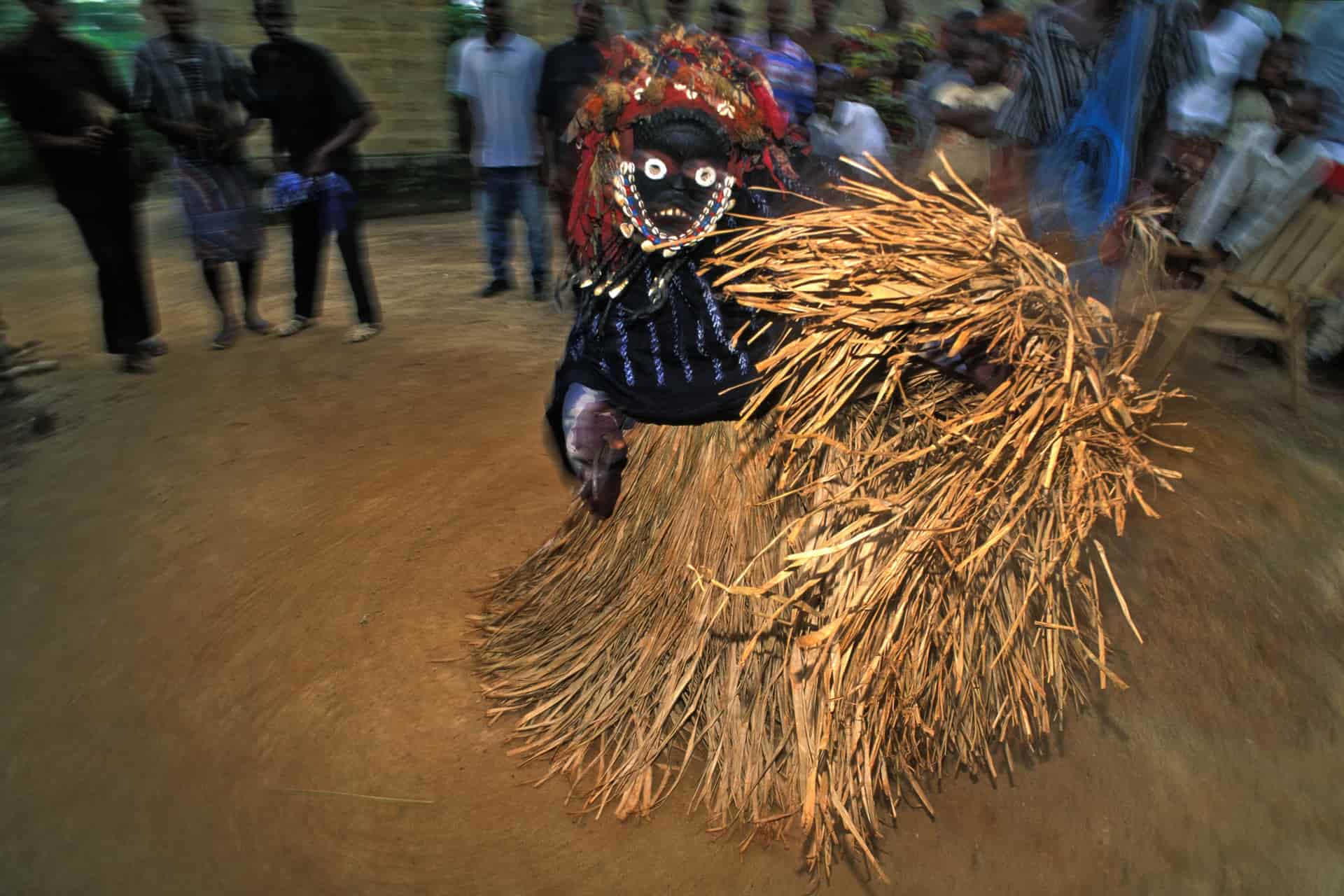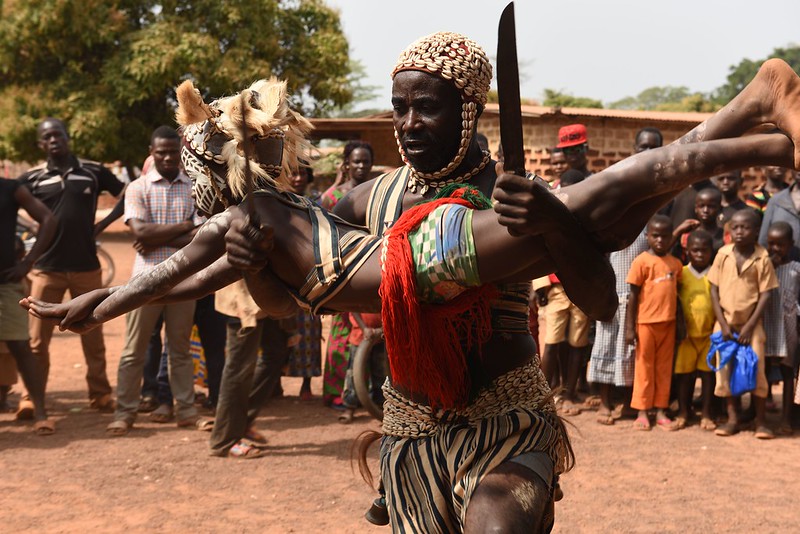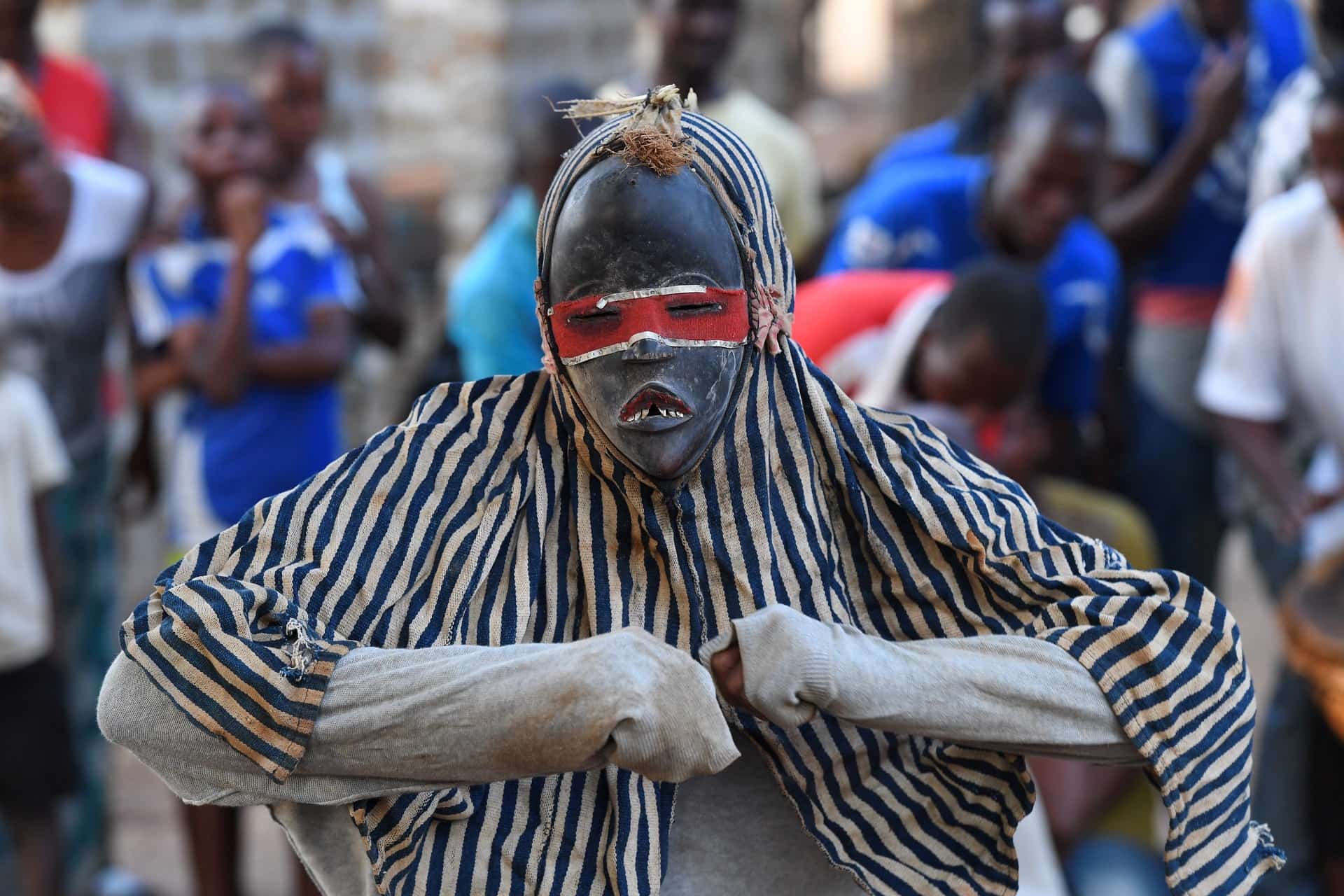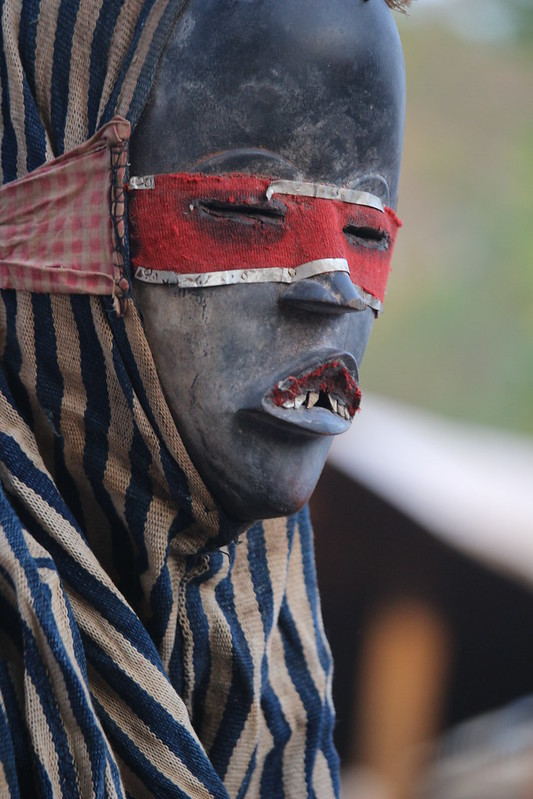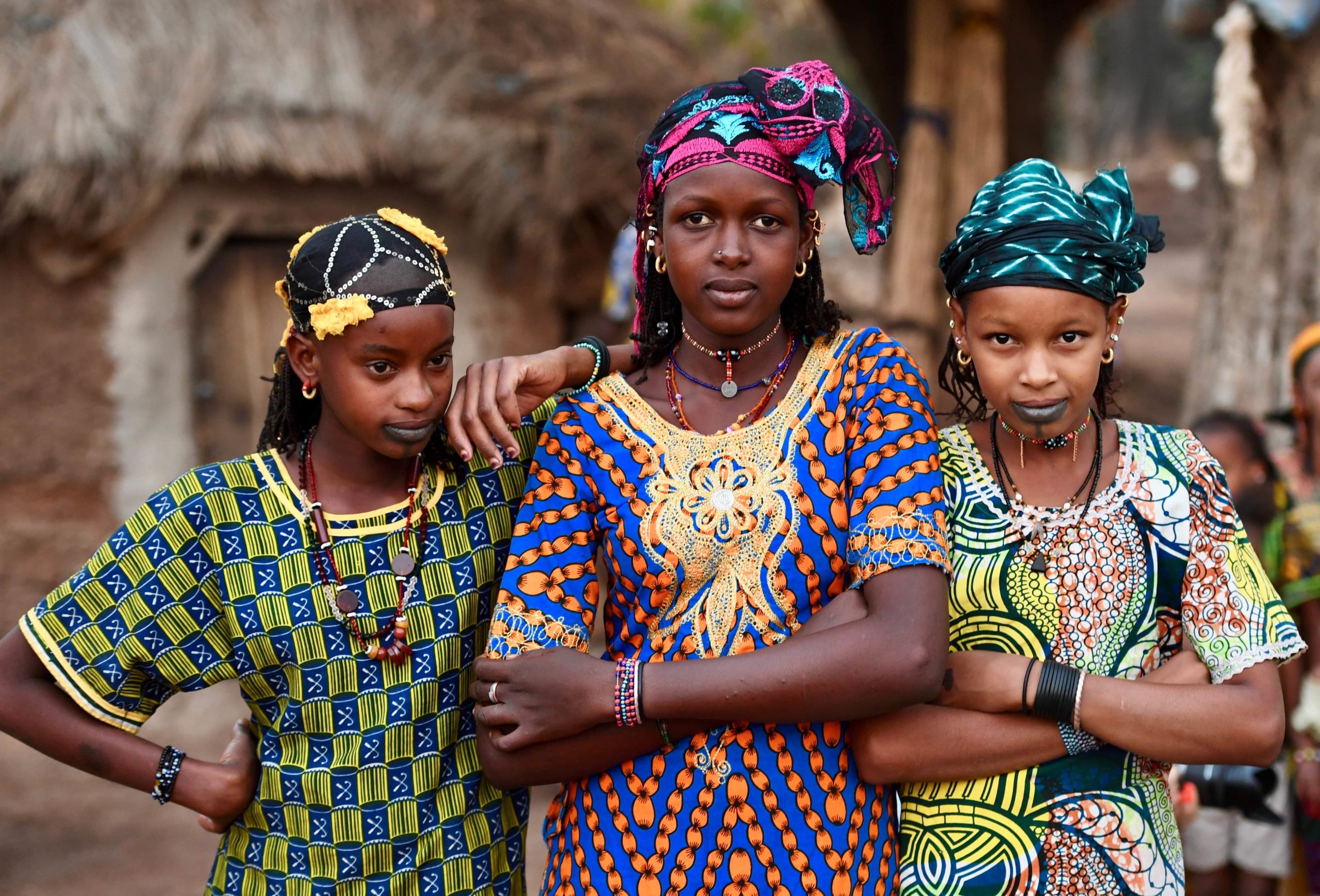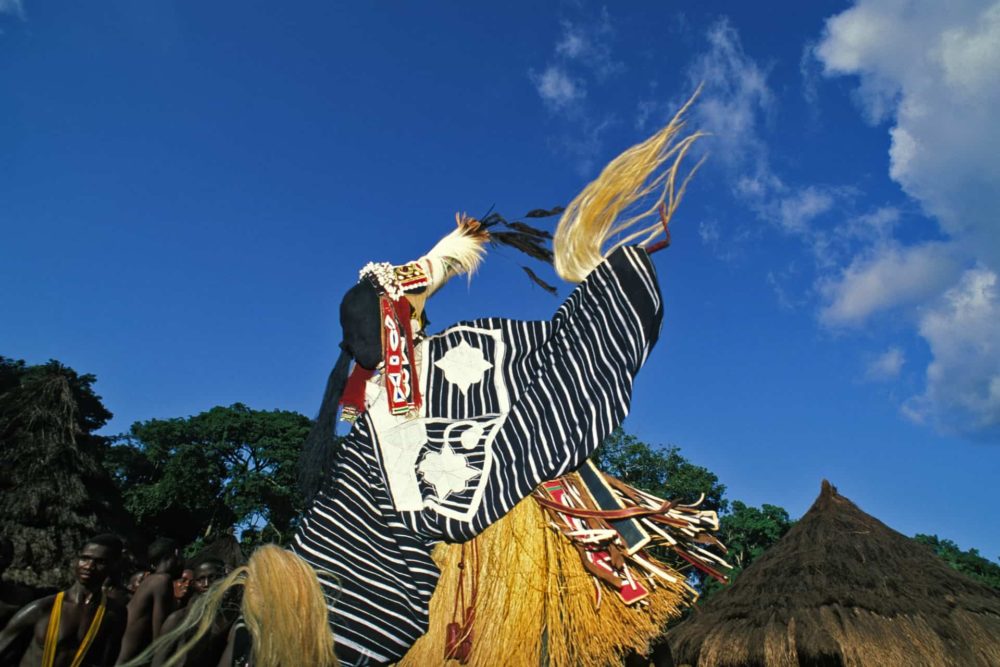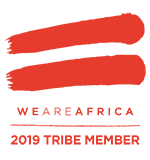Description
IVORY COAST
A journey to a country that only recently becomes again accessible to travellers.
An itinerary for real “pioneers” wanting to discover multi-faced Africa: from liana bridges to cathedrals, from colourful masks to initiation dances, sacred totemic animals and tribal kingdoms.
From traditional hunters’ villages to the skyline of Abidjan, from forests to savannah ending on the Ocean wild beaches.
Every day will be filled with surprises and will take you to genuine, vibrant and colourful traditional ceremonies.
For travellers who enjoy “unfiltered” journeys in Africa, avoiding long drives.

DAY 1: Abidjan, Gulf of Guinea
Arrival in Abidjan and transfer to the hotel.
DAY 2: Forest Kingdoms, from Abidjan to Abenguru (260 km – driving time 5 hrs)
Departure to a region bordering Ghana
Later this morning we will meet a community of Komians. With a bit of luck, we might attend the divinatory dance.
The Akan people of the Ivory Coast use the word “Komian” to refer to trance, a spiritual possession. This term can also be applied to people and in this case, it refers to those persons, mainly women, who have been initiated to communicate with the world of spirits through different divinatory ways, such as the throwing of shells, the vision on water or the dance. Dance is indeed the most spectacular divinatory form and is called to solve the most complex problems. Facing the interlocutor, some family members, and the curious crowd, accompanied by the rhythm of tam-tams, the Komian does a ritual dance until she reaches the status of trance: the spirit will then manifest itself at the “opening of her mouth” and will indicate the nature of the problem and the way forward.
DAY 3: A basilica in the Savannah, from Abenguru to Yamoussoukro (250 km – driving time 5 hrs)
The origin of the Anyi monarchy goes back to the tradition of Akan large ethnical group that lives in large southwest Ghana and Southeast Ivory Coast. They share with the famous Ashanti Kingdom of Ghana a similar lifestyle linked to the wealth of the forest and the cult of kings. At the royal palace, we will meet some senior members of the nobility, in their ceremonial robes, and the priest in charge of the fetish protecting the throne. This special opportunity will enable us to understand the history of the region and the role of traditional Kings in a modern republic. If available, we will be received by one of them.
Arrival in Yamoussoukro, the country’s capital since 1983. It is the native village of Felix Houphouët-Boigny, the first President of the Ivory Coast and one of the greatest independence leaders. He implemented agricultural developments which created a wealthy middle class of planters and farmers. Economic success attracts immigrants from neighbouring Sahel countries and western foreign investors, thus making the Ivory Coast the giant economy of French speaking West Africa. In Yamoussoukro, the formal political capital, and in Abidjan, the economical capital, the Ivorian dream of the 1970s and 1980s has become real. The dream of a country that has managed to rival European capitals in terms of architecture and size of buildings. With the death of Houphouët-Boigny, the town of Yamoussoukro has remained the formal capital however the president, ministries, government, and administration are in Abidjan. After a period of crisis that degenerated in a long civil war, Ivory Coast has again found peace and stability, and it has achieved one of the fastest economic growth in Africa.
A “child” of the economic boom of 1980s is the Basilica of Notre Dame de la Paix (Our Lady of Peace). According to the 1989 Guinness Book of Records, its width of 150 m. made it the largest Christian religious building in the world (Saint Peter’s in Rome is “only” 115 m. wide). And with its 7,763 square meters of stained glass, it also boasts the biggest stained-glass section in the world. Its architecture was inspired by St. Peter’s Basilica in Rome.
In present Yamoussoukro cars drive in wide boulevards constantly trying to avoid big potholes and free roaming chickens! During the visit our attention will also be caught by the huge government buildings, the lofty 14-floor high hotels and the artificial lake which is inhabited by caimans. And yet, among all this, what mostly strikes our imagination is the feeling of emptiness, the nothingness that surrounds what has become a bygone dream.
DAY 4: Akan lineage, from Yamoussoukro to Bouake (no direct way: 260 km – driving time 5 hrs)
We meet the Baulé people from the Akan lineage as the Anyi. Arrived in this land from East, Baule have enriched their cultural traditions by taking cues from their neighbours.
This cultural integration has produced a rich culture, reflected for example in the complex craftmanship: fine statues representing the world of spirits, sculpted weaving-loom pulleys, and beautiful masks.
We attend Zaouli dancing masks. Zaouli is a traditional dance of the Guro people. The Zaouli mask, used in the dance, was created in the 1950s, reportedly inspired by a girl named “Djela Lou Zaouli”. However, stories about the origins of the masks are varied and each mask can have its own symbolic history.
Later we attend the dance of Goli masks, that can be performed for both entertaining and celebrating the funeral of a person of high rank. The Baulé tribe adopted this ritual from their neighbours, the Wan tribe, after 1900. While celebrating peace and joy, the participants will sing, dance and drink palm wine.
DAY 5; In the Senufo savannah, from Bouake to Korhogo (225 km – driving time 6 hrs)
Morning drive in North direction, the landscape will gradually change from bushland to open Savannah with large Baobabs.
The town of Korhogo is a must for any traveller visiting Ivory Coast northern regions. Its history dates to the XIII century and today it is the capital of the Senufo, the tribe that has produced some of the greatest artworks of Africa, in almost every field: sculpture, weaving, painting and blacksmiths. Visit of the interesting craft market to discover wooden sculptures and textiles showing the traditional Senufo patterns. It is these patterns that have inspired modern artists like Pablo Picasso who also personally travelled to Senufo country to meet and exchange experiences with local artists.
The Senufo are renowned for their complex initiation rites. Poro, the male initiation rite, is a long process which takes 21 years to be completed. It is the passage from youth to adulthood and it consists in learning the social and religious secrets that turn a boy into a genuine Senufo man.
We drive North to a remote village to witness the old technique of iron melting carried out by some old blacksmith, a very rare example of traditional iron metallurgy in Africa. This “tribal technology” will bring us back to the first Iron Age in Africa, referring to the prehistory and protohistory of Afro-Eurasia, the time when the dominant tool making material was iron. Some evidence from historical linguistics suggests that iron smelting may have been practiced by the Nok culture of Nigeria from as early as 1000 BC. The nearby Djenné-Djenno culture of the Niger Valley in Mali shows evidence of iron production from c. 250 BC.
The iron ore comes from some local mines in the shape of deep pits and it is milled manually. The traditional “adobe bellows furnace” is loaded with layers of charcoal and layers of ore then the fire is set – we can now leave the furnace since the fusion will take till the following morning. Iron smelting techniques are secret and always associated to taboos and initiations. The blacksmith is endogamous, meaning that only those born into blacksmith families are eligible for the long apprenticeship into the craft. They are feared by the tribe since they possess obscure magical powers, are in contact with evil spirits, are capable to transform stones into iron. Smelting means transforming a solid shape in liquid and transforming it again in solid different shape. They are considered “masters of the fire”, capable of calling upon the “spirits of the earth” with their powerful hammers. Due to their scaring magical powers, blacksmiths often must settle outside of the villages. They are a highly powerful cast: the fabrication of iron tools and iron weapons allows extensive agriculture, efficient hunting, and successful warfare.
Arrival in the evening to our comfortable hotel in Korhogo where we will spend two nights.
DAY 6: The Panther Dance and Iron age. Korhogo (transfers and 60 Km)
In the morning return to the village to see the result of the fusion. The sealed base of the clay furnace will be broken to extract the iron bloom and the blacksmith will pound part of it. Afterwards, with the aid of a bellows, he will heat the metal powder obtained until it melts in a crucible, and he will pour it into a mould. The metal is later heated once again and hammered on the forge to the required shape, which finally will be polished from imperfections and bumps. We have witnessed the whole process leading to the creation of an object. Traditional iron metallurgy is a rare example of an ancient “tribal technology”. For more than 80 years it was believed that this technique had disappeared … up to the discovery of this village!
Back to Korhogo.
The most spectacular Senufo mask dance is the Boloy, known as panther dance, performed by initiated.
DAY 7: The virgins’ dance, from Korhogo to Boundiali (150 km – driving time 5 hrs)
We will leave the main road to discover the village of Niofoin with its clay granaries, decorated with symbolic bas-reliefs, and with a unique sacred house boasting a tall conical roof. The house has painted decorations and sacred objects belonging to the animistic cults, still practiced by Senufo people.
Late in the afternoon, we attend the dance of the virgin girls – called Ngoro, performed by the Senufo and part of the Poro Initiation. The young initiates spend months together in secluded sacred groves where they learn the social and religious secrets that turn a girl into a genuine Senoufo. After seven years there is a big celebration for those who have undergone all stages of initiation, in particular the dance of the virgin girls is performed at the end of the first stage of initiation.
DAY 8: Sacred warriors, from Boundiali to Odienne (150 km – driving time 5 hrs)
We start our day by meeting with the unmistakable Fulani nomads, constantly in search of pastures for their herds of zebus. The Fulani can be easily recognized by their conical straw huts, the walking stick they always carry over their shoulders, the water bottle hanging around their neck, the machete in their hands and their proud posture. These nomads seem to come from nowhere and head nowhere. Accustomed as they are to a hard life, they look perfectly fine with the little they carry. They are the true gentlemen of these endless savannahs. Visit of a village, mostly inhabited by women and children. We will be invited into their huts to see old family photos, dowry presents etc. Women wear beautiful, coloured fabrics and, around their necks and in their hair, very special tribal jewellery (Baltic amber, pearls of Bohemia, old Venetian “murrines”, stones, buttons and any other plastic object they may like).
In the region of Odienne we will meet the Malinké, descendants of the old Mali Empire. The history of this ethnic group includes Samory Touré, a leader and slave hunter who became famous for his war against the French colonial army which was able to defeat him only after many years of fighting. His army included the Dozo (initiated hunters) known for their courage and mystic powers. Although there are no longer wars to fight, this lineage continues to get unabated respect and their mystic powers are still passed on through a long initiation process. Today they are considered a sort of local police, guardian angels watching over villages, mediators of disputes and of course great healers. Brave and with a perfect knowledge of the territory, they are employed by the government to secure the northern borders of the country.
We will encounter the Dozo and walk in the savannah with them – dressed in their traditional costumes made of “bogolan” fabric and carrying their shotguns covered with amulets. They will give us an interesting introduction to traditional herbal medicines and will take us to a sacred site where, to the growing rhythm of tam-tams, they will dance and give proof of their strength
DAY 9: Acrobatic masks, from Odienne to Man (270 km – driving time 5 hrs)
The day is dedicated to the encounter with the Yacuba, also known as the Dan.
We visit villages built on hillsides and characterized by big round huts with thatched roofs – some of the houses are decorated with frescos made by women during ceremonial periods.
Amid scented branches of coffee plantation and in the shadow of an enormous Iroko tree, we visit a large pond inhabited by venerated catfish, custodians of ancestors. Soon the echoes of tam-tams and the shouts of the initiated tell the masks that it is time to leave the sacred forest … so they appear and offer us unforgettable emotions.
We move southwards and when Mount Tonkpi with its “tooth” comes into view we know we are close to our destination: Man.
Man was developed at the bottom of 18 extremely green mountains and is the capital of the We and Guéré ethnic groups.
DAY 10: Liana bridges, from Man to Danani region and back (200 km – driving time 5 hrs)
We discover the rainforest that stretches between Ivory Coast, Liberia, and Guinea famous for its long liana bridges. It is shrouded in mystery. Tradition says that they are secretly built by young, initiated men over the course of only one night! The crossing is not difficult, taboos are respected, and no heavy load or babies are carried along.
In a nearby tiny village, masks will emerge from the forest towards us. In the cosmogony of the Dan Guéré people, there is a creator god that communicates with humans only through its intermediaries, the masks: during the mask dance the distance between the human and the spirit worlds disappears, the cosmic and the social orders are restored, and gratitude is expressed to the gods and the ancestors.
Day 11: Rituals in the forest, Man (transfers and flight to Abidjan)
Vehicles 4×4 will be necessary to discover the remote forest region where the arrival of foreigners is a rare event. The track crosses wooden bridges before reaching the more isolated settlements inhabited by the Guéré ethnic group. The sacred and spectacular masks will dance for the village.
Drumming will announce the rare “Jongleurs” performances. Jongleurs are an ancient tradition now vanishing. Initiated girls with their face painted in white Kaolin perform a unique acrobatic dance… In the afternoon transfer to airport and flight to Abidjan.
DAY 12: Skyscrapers & lagoons, from Abidjan to Grand Bassam (50 km)
If we look beyond the lagoon, the Plateau (the City District) is growing very fast, not horizontally as in most African towns but vertically, with its large modern buildings and skyscrapers. Not much land is available and the little that must be continually reclaimed from the waters of the Ebrié Lagoon. The modern City District is defined to the west by the harbour and its endless queues of people waiting for a ferry, and to the east by the incredible silhouette of Saints Peter & Paul Cathedral.
Our visit begins with a ride on public ferry for a general view of the Plateau from a water’s perspective. From the extremely lively market of Treichville, we move to the peaceful and quiet Cocody, an elegant residential area hosting the Prime Minister’s office and some white colonial buildings.
In the Youpugon quarter, we meet the Fanico, laundrymen washing clothes in the river and drying them on the surrounding grass hill. Hundreds of colourful clothes and fabrics lying on the grass create a giant patchwork. We then visit the National Museum with its tribal art collection displaying masks and statues from various Ivory Coast ethnic groups.
Drive to Grand Bassam
DAY 13: Grand Bassam, old colonial atmosphere, from Grand Bassam to Abidjan (50 km)
Grand Bassam is an old town built on a sand bank between the lagoon and the ocean. It was the former capital of the French Ivory Coast colony. Thanks to its calm avenues shaded by tall trees, large bougainvillea and well-preserved colonial buildings, Grand Bassam has a magic atmosphere. The old post office is a jewel of French colonial architecture. The Costume Museum, in the former governor’s palace, with its large outer staircase is a true architectural gem and its unique collection of tribal costumes, masks, ornaments and ethnographic photographs gives an interesting perception of the country history and culture.
Final transfer to airport.

